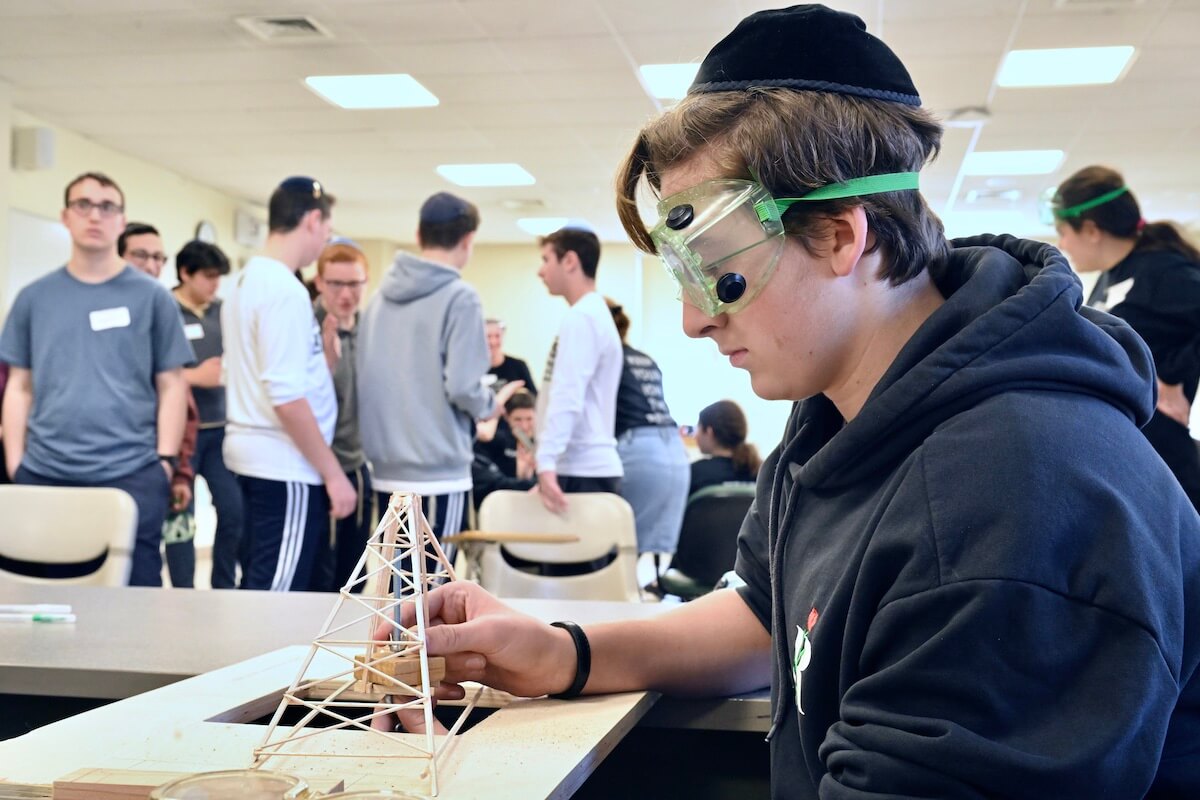Tristate High School Students Face Off in Science Olympiad
Annual Competition at Lander College for Men Builds STEM Skills and Prepares Students for Today’s Job Market

More than a hundred students from 11 high schools in New York and New Jersey competed last month in the Jewish Education Program-Lander College for Men (LCM) Science Olympiad competition. They spent hours vying for the top spot and at the end of the day, Salanter Akiba Riverdale Academy (SAR) finished first, with the Frisch School in Paramus coming in second, followed by North Shore Hebrew Academy in Great Neck, and SKA High School for Girls in Hewlett, respectively.
“It is truly wonderful to return to this in-person competition after missing it for three years during the pandemic,” said Dr. Ann Shinnar, a professor and chair of the LCM chemistry department, during her closing remarks. Since 2012 Dr. Shinnar has served as liaison between LCM and the organizers of the event. “We’re all fortunate that you have teachers who have worked with you to prepare you for the Olympiad today, and hopefully inspired you to go on and continue and develop your interest in science.”
The competition consisted of 13 events related to STEM (Science, Technology, Engineering and Math) research, considered necessary for success in today’s job market. Students from grades 9 through 12 from each of the participating schools competed in at least one event, which tested various aspects of biology, chemistry, anatomy, physiology, earth science, and physics, as well as applications of engineering and technology. Schools were required to send at least two faculty coaches to the Olympiad to supervise students and serve as judges.
“I think the best part is that they learn skills that they don’t really get to explore or develop in their regular classes,” according to Gil Cofnas, who teaches chemistry, physics, and STEAM (the “A” stands for Arts) at Ma’ayanot in Teaneck and accompanied her team to the Olympiad. “A lot of these events are very time intensive, some more than others, and they just put all they could into it. It’s just been amazing.”
A perennial favorite is the Scrambler, where teams construct a vehicle—using wood, elastic bands, compact discs for wheels, and other assorted materials—and push it down a ramp. An egg is placed on top, and the vehicle that goes the furthest, while keeping the egg intact, wins. Students from the different schools gathered around the contestants to watch the event and cheer on their classmates and friends.
During another popular event, Bridge Building, participants were required to construct a small bridge out of wood and glue. To test the stability, a bucket was attached to the bottom of the bridge and then slowly filled with sand until the bridge inevitably broke. Teams earned points according to how much weight their bridges could hold, and the fewer materials used, the higher the potential score. Yoseph Adler and David Shnayder, students at Davis Renov Stahler Yeshiva High School for Boys of the Hebrew Academy of Long Beach (DRS), used a teepee-like design with a swing hanging from its peak to create a bridge that was able to sustain 18.6 kilograms (about 41 pounds) of sand.
“When you place sticks in a diagonal formation, like we did with two across and two in between, it holds really strong—if you press down on the bridge with your hand, it doesn’t move,” Shnayder said of the design, noting that they based it on the concept of triangles being the strongest shape. “And we just made that into a bigger form,” Adler said.
When not competing in events, students watched their friends compete or played games like ping pong, bumper pool, foosball, and pop-a-shot in LCM’s student lounge, while others took turns playing piano.
“It’s so much fun to see all the kids together, cheering each other on from different schools, and when something doesn’t go right, they laugh together,” said Sara Seligson, Managing Director for Day School and Yeshivot Initiatives at the Jewish Education Project. “I’m not a science person at all and it’s just fascinating to see what these kids come up with.”

